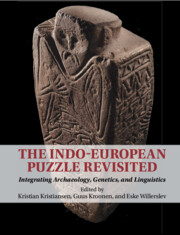Book contents
- The Indo-European Puzzle Revisited
- The Indo-European Puzzle Revisited
- Copyright page
- Contents
- Figures
- Tables
- Contributors
- Preface
- Introduction
- Part I Early Indo-European and the Origin of Pastoralism
- Part II Migratory Processes and Linguistic Dispersals between Yamnaya and the Corded Ware
- Part III The Cultural and Linguistic Significance of Bell Beakers along the Atlantic Fringe
- 9 From the Steppe to Ireland: The Impact of aDNA Research
- 10 Beaker Culture Metal and Mobility in Atlantic Europe: Some Implications for Genetic and Language Origins
- 11 “From the Ends of the Earth”: A Cross-Disciplinary Approach to Long-Distance Contact in Bronze Age Atlantic Europe
- 12 With the Back to the Ocean: The Celtic Maritime Vocabulary
- 13 European Prehistory between Celtic and Germanic: The Celto-Germanic Isoglosses Revisited
- Part IV The Bronze Age Chariot and Wool Horizons
- Part V Kinship Systems, Marriage, Fosterage, Free, and Unfree
- Concluding Reflections
- Index
- References
13 - European Prehistory between Celtic and Germanic: The Celto-Germanic Isoglosses Revisited
from Part III - The Cultural and Linguistic Significance of Bell Beakers along the Atlantic Fringe
Published online by Cambridge University Press: 29 April 2023
- The Indo-European Puzzle Revisited
- The Indo-European Puzzle Revisited
- Copyright page
- Contents
- Figures
- Tables
- Contributors
- Preface
- Introduction
- Part I Early Indo-European and the Origin of Pastoralism
- Part II Migratory Processes and Linguistic Dispersals between Yamnaya and the Corded Ware
- Part III The Cultural and Linguistic Significance of Bell Beakers along the Atlantic Fringe
- 9 From the Steppe to Ireland: The Impact of aDNA Research
- 10 Beaker Culture Metal and Mobility in Atlantic Europe: Some Implications for Genetic and Language Origins
- 11 “From the Ends of the Earth”: A Cross-Disciplinary Approach to Long-Distance Contact in Bronze Age Atlantic Europe
- 12 With the Back to the Ocean: The Celtic Maritime Vocabulary
- 13 European Prehistory between Celtic and Germanic: The Celto-Germanic Isoglosses Revisited
- Part IV The Bronze Age Chariot and Wool Horizons
- Part V Kinship Systems, Marriage, Fosterage, Free, and Unfree
- Concluding Reflections
- Index
- References
Summary
Recent advances in the field of palaeogenomics have revealed that at the onset of the Late Neolithic, Europe was characterized by a major cultural and genetic transformation triggered by multiple population movements from the Pontic–Caspian steppe. Corded Ware populations show a large-scale introduction of Yamnaya steppe ancestry across the entire archaeological horizon (Allentoft et al. 2015; Haak et al. 2015; Malmström 2019). The emergence of the Bell Beaker burial identity in the early third millennium BCE was similarly accompanied by a dramatic genetic turnover, at least in Northwestern Europe (Olalde et al. 2018). These population changes call for the integration of genetic evidence into existing models for the linguistic Indo-Europeanization of Europe (cf. Kristiansen et al. 2017).
- Type
- Chapter
- Information
- The Indo-European Puzzle RevisitedIntegrating Archaeology, Genetics, and Linguistics, pp. 193 - 244Publisher: Cambridge University PressPrint publication year: 2023



